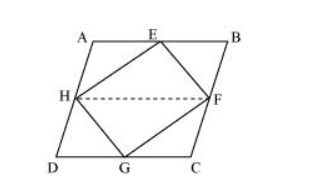Question.
If $\mathrm{E}, \mathrm{F}, \mathrm{G}$ and $\mathrm{H}$ are respectively the mid-points of the sides of a parallelogram $\mathrm{ABCD}$ show that $\operatorname{ar}(\mathrm{EFGH})=\frac{1}{2} \operatorname{ar}(\mathrm{ABCD})$
Solution:

Let us join HF.
In parallelogram ABCD,
AD = BC and AD || BC (Opposite sides of a parallelogram are equal and parallel)
AB = CD (Opposite sides of a parallelogram are equal)
$\Rightarrow \frac{1}{2} \mathrm{AD}=\frac{1}{2} \mathrm{BC}$ and $\mathrm{AH} \| \mathrm{BF}$
$\Rightarrow \mathrm{AH}=\mathrm{BF}$ and $\mathrm{AH} \| \mathrm{BF}(\because \mathrm{H}$ and $\mathrm{F}$ are the mid-points of $\mathrm{AD}$ and $\mathrm{BC})$
Therefore, $\mathrm{ABFH}$ is a parallelogram.
Since $\triangle \mathrm{HEF}$ and parallelogram $\mathrm{ABFH}$ are on the same base $\mathrm{HF}$ and between the same parallel lines $\mathrm{AB}$ and $\mathrm{HF}$,
$\therefore$ Area $(\Delta \mathrm{HEF})=\frac{1}{2}$ Area $(\mathrm{ABFH}) \ldots$(1)
Similarly, it can be proved that
Area $(\Delta H G F)=\frac{1}{2}$ Area $(H D C F) \ldots$(2)
On adding equations (1) and (2), we obtain
Area $(\Delta \mathrm{HEF})+$ Area $(\Delta \mathrm{HGF})=\frac{1}{2}$ Area $(\mathrm{ABFH})+\frac{1}{2}$ Area $(\mathrm{HDCF})$
$=\frac{1}{2}[$ Area $(\mathrm{ABFH})+$ Area $(\mathrm{HDCF})]$
$\Rightarrow$ Area $(\mathrm{EFGH})=\frac{1}{2}$ Area $(\mathrm{ABCD})$

Let us join HF.
In parallelogram ABCD,
AD = BC and AD || BC (Opposite sides of a parallelogram are equal and parallel)
AB = CD (Opposite sides of a parallelogram are equal)
$\Rightarrow \frac{1}{2} \mathrm{AD}=\frac{1}{2} \mathrm{BC}$ and $\mathrm{AH} \| \mathrm{BF}$
$\Rightarrow \mathrm{AH}=\mathrm{BF}$ and $\mathrm{AH} \| \mathrm{BF}(\because \mathrm{H}$ and $\mathrm{F}$ are the mid-points of $\mathrm{AD}$ and $\mathrm{BC})$
Therefore, $\mathrm{ABFH}$ is a parallelogram.
Since $\triangle \mathrm{HEF}$ and parallelogram $\mathrm{ABFH}$ are on the same base $\mathrm{HF}$ and between the same parallel lines $\mathrm{AB}$ and $\mathrm{HF}$,
$\therefore$ Area $(\Delta \mathrm{HEF})=\frac{1}{2}$ Area $(\mathrm{ABFH}) \ldots$(1)
Similarly, it can be proved that
Area $(\Delta H G F)=\frac{1}{2}$ Area $(H D C F) \ldots$(2)
On adding equations (1) and (2), we obtain
Area $(\Delta \mathrm{HEF})+$ Area $(\Delta \mathrm{HGF})=\frac{1}{2}$ Area $(\mathrm{ABFH})+\frac{1}{2}$ Area $(\mathrm{HDCF})$
$=\frac{1}{2}[$ Area $(\mathrm{ABFH})+$ Area $(\mathrm{HDCF})]$
$\Rightarrow$ Area $(\mathrm{EFGH})=\frac{1}{2}$ Area $(\mathrm{ABCD})$
Click here to get exam-ready with eSaral
For making your preparation journey smoother of JEE, NEET and Class 8 to 10, grab our app now.
